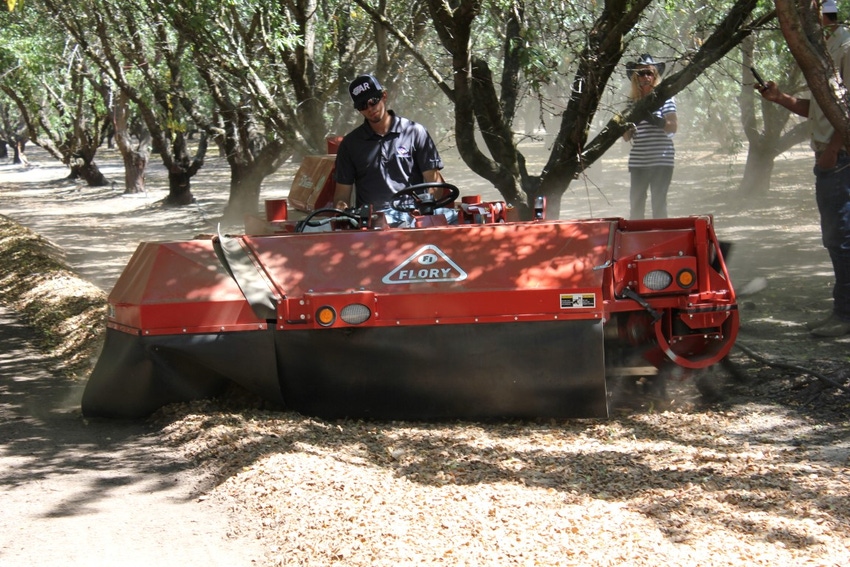
“People love our product — but they may not love living next to your orchards,” says Gabriele Ludwig of the Almond Board of California.Steps to avoid dust drifting into neighborhoods and traffic include blowing dust back into the orchard and using the tree canopy as a natural filter.
July 16, 2016

Robert Willmott, orchard technician at California State University, Fresno, understands all too well what happens when he and his student staff send clouds of dust into the sky over an almond orchard during harvest.
Drivers on the busy Freeway 168 that borders one side of the orchard aren’t happy about the dust. Nor are those who live in houses on the other three sides, or the joggers and bicyclists on nearby paths.
But in California almond orchards, dust happens.
However, Willmott explained at a recent Almond Board of California (ABC) workshop on harvest practices that steps taken to avoid dust drifting into neighborhoods and traffic include blowing dust back into the orchard and using the tree canopy as a natural filter.
“People love our product — but they may not love living next to your orchards,” said Gabriele Ludwig, ABC director of sustainability and environmental affairs.
In often blunt terms, she cautioned growers that industry expansion has put them in the public spotlight, and under the scrutiny of regulators, environmental activist groups, the media, and a generation-changing population.
Millennials - those who reached young adulthood by 2000 - are among those who are unflinchingly demanding more information about how their food is produced.
“You need to tell your story,” Ludwig said. “Others are trying to define us, and we need factual information to counter the stories they tell.”
To document the story, the Almond Board collects information on steps being taken to enhance sustainability.
It’s free – Western Farm Press Daily – agricultural news delivered to your Inbox.
Power in data
Cliff Ohmart, vice president of professional services for SureHarvest at Davis, Calif., said, “There is power in data, so use it to your benefit.”
Ludwig and Ohmart responded to a question from the audience about data that the ABC collects. They believe growers are more likely to be advantaged rather than disadvantaged by documentation the board intends to keep private.
Some growers expressed concerns about confidentiality, a point raised by H. Barrett Arakelian, grower field representative with Del Rio Nut Co. in Livingston. As he was filling out a self-assessment form for grower practices, he paused for an interview.
Arakelian said, “Farmers want to be transparent, but there is a fear in the industry that some may litigate” to collect data. He recognizes a changing world and the need to respond.
The “younger generation expects transparency,” Ludwig said, emphasizing that she receives “group information, not personal information.” Taking the time to do a self-assessment of growing practices is “a time to reflect.”
Those interested in the California Almond Sustainability Program can get additional information at www.sustainablealmondgrowing.org.
Speaking on the dust issue, Ludwig said it will likely never go away, but its effects can be mitigated through simple adjustments to equipment and timing.
“If a school is nearby, avoid harvesting when classes are in session. Determine how many passes you really need, and make adjustments so the sweeper is not set too low.”
If pickers are at work in a neighboring vineyard, avoid sending clouds of dust their way.
Steps to limit dust
A video outlined steps for minimizing dust and its effects. They include starting with a clean orchard floor that’s free of ruts, going slowly, and setting sweeper heads no lower than necessary to recover the crop. Often, wire tines can be set as high as one-half inch off the ground and still do a good sweeping job.
If possible, it’s best to use wire tines on sweeper heads. Sweepers with wire tines without rubber flaps help reduce the amount of dust. And one blower pass instead of three can reduce the amount of dust in half.
Workshop participants were told that USDA’s Natural Resources Conservation Service provides assistance to growers for reducing the impact of harvesting on air quality if the emissions reduction is at least 30 percent.
It’s free – Western Farm Press Daily – agricultural news delivered to your Inbox.
You May Also Like



